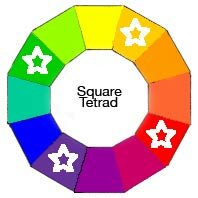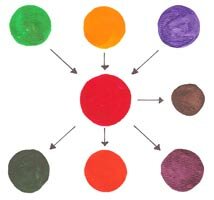Square Tetrad Color Scheme

Working with a Square Tetrad on your Color Wheel means juggling four colors. Simply put, you’re choosing a square offour colors on the basic color wheel.
Another quick way to select your color palette is to start with your main Mother Color. Because a Color Wheel containstwelve basic colors, forming a square is easy. Work your way around picking every third Hue.
Notice that you are always working with two pairs of Complementary Colors. This can make things a bit tricky if you mix thoughtlessly. Your mixtures can quickly become darkunless you blend colors very gradually.
This Color Scheme always contains 1 Primary, 1 Secondary and 2 Tertiary Colors. Each of these four Hues has the potential to dramatically neutralize or brighten the other when mixed together.
There are only three different combinations possible as the square moves around the wheel. However, twelve versions of those three combinations can be created depending on which Hue you select as your dominant Mother Color.
Any Tetrad consists of four hues making a squarish shape. In addition to a Square Tetrad, there are two other possible color schemes in this format. Experiment with all three to see which one you like best
Example of a Square Tetrad Color Scheme

Red is the dominant Mother Color and placed in the middle. Pure Green, Yellow/Orange and Blue/Violet are shown on the top row.
By adding a tiny bit of Red to the three paint colors on the top row, you’ll get some interesting results which you can see on the bottom row. The original harshness of the colorsharmonize and become a ‘family’. If you add more red to each the colors will change even more.
Green + a little Red = Dull Khaki Green
Yellow/Orange + a little Red = Intense Orange
Blue/Violet + a little Red = Burgundy
The Neutral Brown in the middle row on the right is a mixture of all four starting colors.There’s no guesswork as to which neutral to use, because all these colors are part of a blended family.
Even though the mixtures on the bottom row no longer clash, they’re still a bit challenging to balance. That intense orange will need to be used in small doses to keep from overpowering the other more subdued mixtures. It will help to add white to lighten, black to darken and grey to tone down brighter paint mixtures a create a broader range of colors.
A Square Tetrad color palette always makes a bold statement. That’s because every combination will always contain one Primary with its Complementary Secondary Color plus two Tertiary Colors equally distant from each other. This can be a great advantage if you fully understand how they react to each other.
Spend some time experimenting with these color combinations. The results can be very striking.
Painting Tips for Square Tetrad Color Scheme
- Make one of your colors dominant in your palette. This is your Mother Color. To absolutely make sure your colors don’t clash, put a TINY smidgen of it in every mixture. Keep itsubtle for best results.
- Use various intensities of your chosen hues by mixing different proportions. Then adjust the values by creating tints, shades and tones.
- For contrasting accents, choose one of the non-dominant colors. Make sure it has a tiny bit of the dominant Mother Color mixed in to soften it a touch.
- Before you start a project, experiment with various balance of mixtures on a piece of paper or in your sketchbook as reference. It will give you a better feel of the full range of colors you can achieve.
- Some pigments mixed in will be strong and overpower your starting color. Only mix a tiny bit at a time until you know your pigments well. Beware of the darkest colors Blue, Violet and Black.
Check out these Color Schemes
Complementary
Near Complementary

